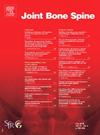Clinical enthesitis in patient with psoriatic arthritis, a systematic literature review with meta-analysis
IF 3.8
3区 医学
Q1 RHEUMATOLOGY
引用次数: 0
Abstract
Objectives
Enthesitis is considered a hallmark of psoriatic arthritis (PsA). The objective was to assess clinical enthesitis in PsA including its prevalence in different contexts, scores used and consequences of enthesitis.
Methods
A systematic literature review with meta-analysis was conducted in PubMed 2010–2023, focusing on manuscripts involving adult PsA patients and reporting information related to enthesitis. Data collected included the prevalence of clinical enthesitis (i.e., number of patients with at least one enthesitis); scores used: Leeds Enthesitis Index (LEI), MASES, SPARCC; and impact of enthesitis on disease activity, patient-reported outcomes and use of analgesics. Univariate random-effects meta-analysis was applied for pooling percentages and means.
Results
Overall, 212 studies, i.e., 84,262 PsA patients were analyzed. The pooled prevalence of enthesitis in the overall population was 41.6% [95% confidence interval, 37.4–45.8]; with 67.2% [62.0–72.6] in trials and 27.8% [24.5–31.2] in observational studies. The number of enthesitis varied according to the score used, with the lowest observed for the LEI, which was the most widely-used score (63.7%). Patients with enthesitis had higher disease activity and disease burden in comparison with those without enthesitis.
Conclusion
Enthesitis is a frequent manifestation in PsA, concerning close to half the patients, and is more prevalent in trials than in observational studies, reflecting recruitment patterns. The clinical assessment of enthesitis remains challenging, with heterogeneity in the scores used influencing the results: the most used score was the LEI, which also led to the lowest number of enthesitis. Links with patients’ quality of life should be further explored.
银屑病关节炎患者的临床关节炎:系统性文献回顾与荟萃分析。
目的:关节内膜炎被认为是银屑病关节炎(PsA)的特征之一。目的是评估 PsA 中的临床腱鞘炎,包括其在不同情况下的发病率、使用的评分以及腱鞘炎的后果:方法:在PubMed 2010-2023年进行了系统性文献综述和荟萃分析,重点关注涉及成年PsA患者并报告了与关节内膜炎相关信息的手稿。收集的数据包括临床粘连炎的患病率(即至少患有一次粘连炎的患者人数);使用的评分:利兹粘膜炎指数 (LEI)、MASES、SPARCC;以及粘膜炎对疾病活动、患者报告结果和镇痛药使用的影响。采用单变量随机效应荟萃分析法对百分比和均值进行汇总:共分析了212项研究,即84 262名PsA患者。总人群中关节内膜炎的合计患病率为 41.6% [95%置信区间,37.4-45.8];其中试验性研究的患病率为 67.2% [62.0-72.6],观察性研究的患病率为 27.8% [24.5-31.2]。根据所用评分的不同,出现关节内膜炎的人数也不同,使用最广泛的LEI评分中出现关节内膜炎的人数最少(63.7%)。与无关节炎患者相比,有关节炎患者的疾病活动度和疾病负担更高:结论:关节内膜炎是PsA的一种常见表现,涉及近一半的患者,在试验中的发病率高于观察性研究,这反映了招募模式。对腱鞘炎的临床评估仍具有挑战性,所用评分的异质性影响了评估结果:最常用的评分是LEI,它也导致了最低的腱鞘炎患病率。应进一步探讨与患者生活质量之间的联系。
本文章由计算机程序翻译,如有差异,请以英文原文为准。
求助全文
约1分钟内获得全文
求助全文
来源期刊

Joint Bone Spine
医学-风湿病学
CiteScore
4.50
自引率
11.90%
发文量
184
审稿时长
25 days
期刊介绍:
Bimonthly e-only international journal, Joint Bone Spine publishes in English original research articles and all the latest advances that deal with disorders affecting the joints, bones, and spine and, more generally, the entire field of rheumatology.
All submitted manuscripts to the journal are subjected to rigorous peer review by international experts: under no circumstances does the journal guarantee publication before the editorial board makes its final decision. (Surgical techniques and work focusing specifically on orthopedic surgery are not within the scope of the journal.)Joint Bone Spine is indexed in the main international databases and is accessible worldwide through the ScienceDirect and ClinicalKey platforms.
 求助内容:
求助内容: 应助结果提醒方式:
应助结果提醒方式:


